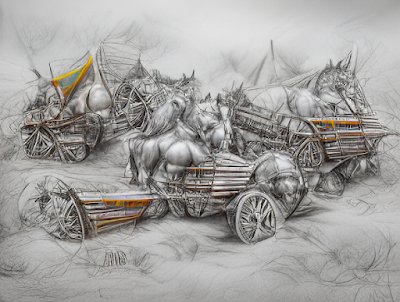I’ve always been a rules junkie. Some 35 years ago, I used to buy those giant Games Workshop boxed sets like Space Marine, Blood Bowl or Space Hulk together with two buddies. Usually the box contained two basic teams/squads/armies/whatever, maybe some scenery, and the rulebook. My friends invariably wanted to get the minis, and I always obliged – because to their astonishment, I wanted to keep the rule booklet. I still have several of those. Decades later, I still enjoy studying a new set of rules nearly as much as bringing an old favourite to the table. I seem to go in phases: I obsess over a specific era/scale for a few months, then shift my attention to something else. Free or commercial, professional or indie, digital or paper – it makes no difference. I just like absorbing the mechanisms and fantasizing about which specific historical engagement would be best served by which ruleset.
Right now,
I’m reading (and re-reading) lots of ancient battles rules. Dozens of them. And
I’m being painfully reminded of one fact: ancient rulesets are the absolute worst of them all to read.
There’s always something painfully convolute in either the prose, the
presentation, or both. My hypothesis is that decades of exposition to the
famously dense DBX jargon subliminally created in ancient players’/designers’
minds an expectation that brevity and clarity are pollice verso.
But there’s
a specific trend in ancient rulesets that is so pervasive and blatant, it makes
me cringe every time. I call it the Wagenburg
Syndrome. Look, ancient battles were not that complex if compared to, say, WW2
engagements at any scale. On the other hand, if one considers the entirety of
pre-gunpowder warfare (and 99% of the rulesets aim to simulate all of it, of
course – how many times did you read ‘3000BC-1500AD’ somewhere in the
subtitle?) you can quickly come up with a lot of pretty weird ways in which our
ancestors tried to kill each other.
Ballistae.
Elephants from different continents. Chariots (many, many types of chariots). Flaming
pigs. Rolling logs. Plaustrellae and Carrocci. Rockets. Experimental
phalanxes, pavisiers, sparabara. Manipular legions. Camels. Cantabrian circles.
Skirmishers. Feigned charges. And of course, the worst of them all – the titular
War Wagons. All of these share a common characteristic – they are probably
quite different from almost any other unit in the game (unless you’re a weirdo
and play an Hussite army). They need rules to move differently, to fight
differently, to shoot differently, perhaps they even have different bases/unit
sizes with respect to every other unit in the game. Rules, rules, rules. As I
said, I like rules – but when, like, 50% of the word count is devoted to
something I’ll use perhaps 5% of the times something starts to feel strange.
But it’s worse than that – almost all
ancient rulesets just put the rules for those exceptional units right into the
basic stuff, the first time they expose it.
Just
imagine a WW2 game trying to do the same. “OK, an infantry squad moves so and
so, but tanks move in this other way, and towed guns like this, unless in a
minefield, oh and then there’s air support, and wheeled vehicles off-road
unless if there’s mud and…” Now, most WW2 game designers are sensible and just
split the rules into individual sections. Why on earth cannot ancient rulesets
do the same? The same approach usually extends to play aids/reference tables.
Modifiers you’ll need once in a blue moon like cavalry against camels, Indian
vs African elephants, light cavalry against war wagons, hoplites at first
contact with hoplites unless during a month sacred to Athena, etc etc are often
maliciously mixed with modifiers you’ll apply in each and every game like, I dunno,
‘contacted in the flank’. Why? Why? [Phil Sabin’s otherwise spectacular ‘Lost Battles’ is a
particularly nasty offender in this respect].
Now, there
are praiseworthy exceptions to this trend. I must cite Fame and Glory's Games "A Game of Knights and Knaves" as a spectacular
example – a game that explains DBX-like basics covering 90% of the situations in
two digest sized pages, then
introduces extra rules as self-contained ‘plugins’. Washington Grand Company’s
“Triumph!” takes a similar route with its ‘battle cards’. Even though not
entirely free of the Wagenburg Syndrome, Battle Array deserves a special
mention in that it introduces rules in discrete chunks interspersed with no
less than 14 learning scenarios. Bravo!







